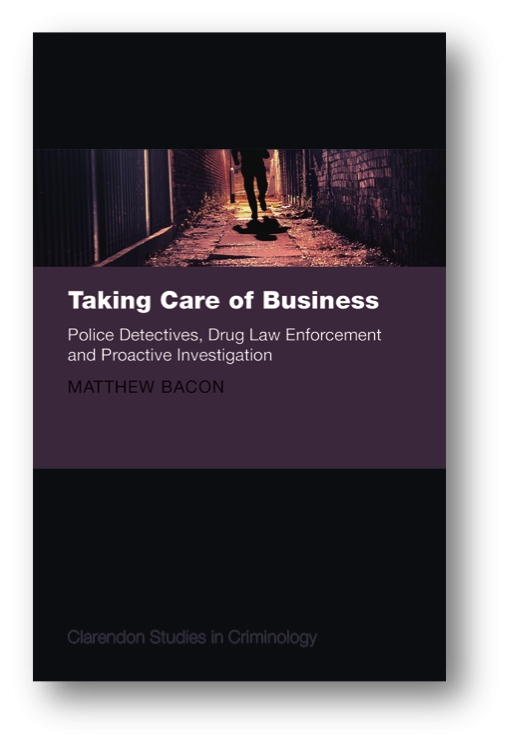
Features
Off the Shelf
Opinion
Taking Care of Business by Matthew Bacon
Taking Care of Business: Police Detectives, Drug Law Enforcement and Proactive Investigation
By Matthew Bacon; 2016, 352 pages
ISBN: 9780199687381
June 15, 2018 By James Sheptycki

How does law and administrative bureaucratic regulation affect the working world of police detectives? This is a crucial question and Matthew Bacon’s ethnographic study of specialist covert drug squads in ‘Smallville’ and ‘Metropolis’ provides an important piece of a very complex puzzle: a theory of policing.
Actually, Bacon’s book has more than one thesis. The author is also interested to understand the relationship between drug law enforcement and illicit markets. He wants to argue that by understanding the regulation of drug markets in terms of harm reduction we can thereby somehow limit the importance and centrality of criminal law enforcement in shaping them. I am pessimistic on this count and tend to agree with scholars of ‘organized crime’ who have argued that prohibition regimes in drugs, alcohol, gambling and other ‘vices’ long ago allowed the organization of criminal enterprise to reach take-off velocity and become self-perpetuating.
Reading Bacon’s book I detect that the old-style ‘drug squad’ is being wound down, indeed the author notes that drug law enforcement was being deprioritized during his period of observation (p. 164), and this may be partly why he was able to gain such remarkable research access. If drug law enforcement is being denuded, one question that arises is: what will be the next assignment for officers who used to work the drug squad?
This is merely to voice questions that reading Taking Care of Business raised for this reader and are by no means intended as criticisms. Bacon’s book is an important contribution to contemporary scholarship in the field and will be usefully mined for insights by academic criminologists and many other types of scholar.
What I found particularly good about this book is the meticulous ethnographic description of the workings of the drug detectives. The discussions about informant handling, the formalities of source and information evaluation and the descriptions of the intelligence process, help the reader to understand the management structure of covert policing.
The guts of the book are three chapters, which provide a faithful description of the routine workings of drug units. Chapter six is about ‘intelligence-led investigation,’ chapter seven is titled “Licensing Criminals” and chapter eight describes police ‘making cases.’ The reader learns how police ‘intelligence’ is selected, shaped, interpreted and acted on at a stage prior to the manufacture of evidence for public presentation in a court of law. Since drugs markets are large, pervasive, elastic and fluid enough to allow for exchange and profit, intelligence-led drug policing can be like shooting fish in a barrel.
As Bacon’s research subjects (police informants?) readily admit, there is more serious drug-related crime than police can feasibly turn into successful cases. Total drug law enforcement is not an option, but what are the criteria of selection? Here the book’s discussion involves consideration of the measurement of harm and concerns about harm reduction. As far as the drug squad is concerned, taking out dealers is what they do because they believe it to be central to effective harm reduction policy.
This book also provides nice brief accounts of the historical origins of the police detective, the war on drugs, and of criminological theories concerning illicit drugs markets. One chapter carefully explains the author’s entry into the field and the process of negotiating research access as well as giving due methodological consideration to the project as a whole. Specialists in these topics may skip over these early chapters or stop to quibble, but novice students will find them to be readable, concise and informative. They help to hold the book together as a thoroughly interesting and compelling read.
– James Sheptycki, McLaughlin College, York University
Print this page